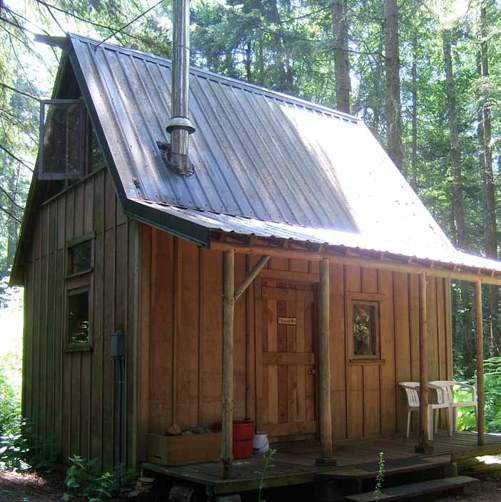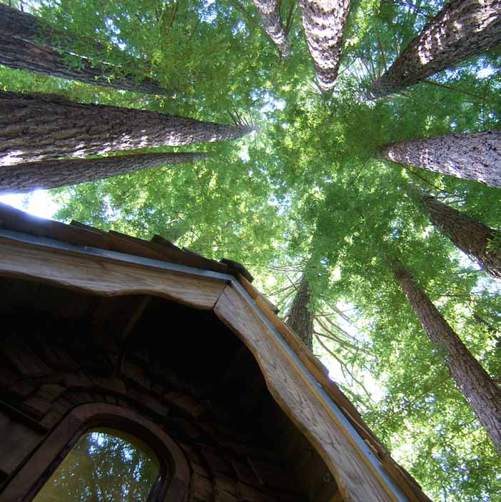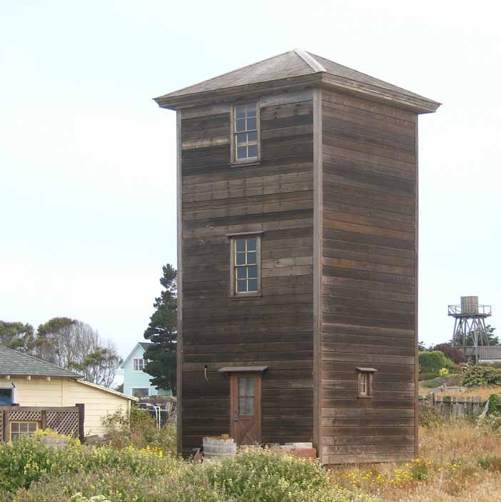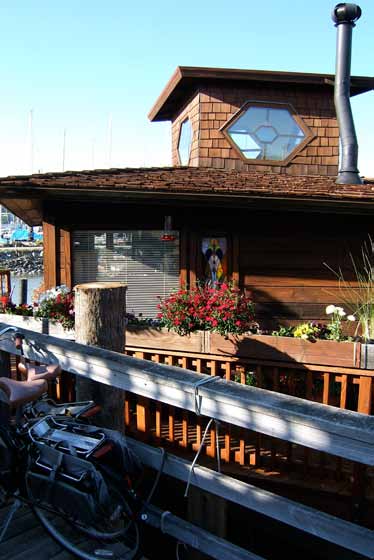The Small House Book (4 page)
Read The Small House Book Online
Authors: Jay Shafer

economy are mutually exclusive. We can have exorbitance, or we can have
the serenity that a sensibly-scaled home affords, but we cannot have both.
Like anything else that is not essential to our happiness, extra space just gets
in the way. It requires maintenance and heating, and ultimately demands that
we exchange a portion of life for the money needed to pay for these extras.
For most Americans, big houses have come to symbolize the good life; but,
all symbolism aside, the life these places actually foster is more typically
one of drudgery. Mortgage payments can appropriate thirty to forty percent
of a household’s income not counting taxes, insurance, or maintenance ex-
penses. When every spare penny is going towards house payments, there is
nothing left over for investments, travel, continued education, more time with
the kids, or even so much as a minute to relax and enjoy life. At this rate, an
oversized house can start to look more like a debtor’s prison than a home.
In 2008, a used house in the U.S. averaged about $244,000. That is far more
than the average American can afford. Affordable housing has, in fact, be-
come the exception. How seldom one hears of moderately-priced real estate
28
A cabin at The Whidbey Institute’s Chinook Conference & Retreat Center (right)




referred to simply as “hous-
ing” and the pricier stuff as
“unaffordable housing. “
The perception of afford-
able housing as something
below par is not solely the
result of this skewed ter-
minology. The structures
produced under the banner
are usually as elephantine
as the more expensive option, but with shoddier materials and even worse
design. Through the eyes of the housing industry, square footage pays; qual-
ity does not.
Square footage is really the cheapest thing that can be added onto a house.
The electrical system, plumbing, heating, appliances and structural compo-
nents of most any dwelling are similar in at least one key way. They are all
expensive. This costly core is housed by the relatively cheap volume that
surrounds it.
In light of all this, it might seem that you really can’t afford to buy anything
less than the most house you can get your hands on. At first glance, it ap-
pears that the more you buy the more you save, but it’s the hidden costs that
get people into trouble. After all, more house than you need comes with more
debt in total, more utility bills, more maintenance than you need and more
foreclosures and more bailouts than any of us needs ever again.
Houses in Langly, WA, Bodega, CA and Mendocino, CA (pages 29, 30 & 31, respectively)
32
Taos Pueblo (above) and a house on Highway 550 in New Mexico (right)


Aesthetics
Today’s market suggests that, for many of us, the perceived prestige of enor-
mity takes precedence over design and even structural integrity when choos-
sing a home. It seems that even a shoddy status symbol, with its expansive
vinyl walls and snap-on plastic window grills, can somehow connote distinc-
tion. The finer qualities of design have become as difficult to market as they
are to achieve, so they are being replaced by highly-prized square footage.
Just as something is typically appre-
ciated as good or beautiful when it
is deemed necessary, it will be con-
demned as ugly or evil when it is
considered pointless. Under the right
circumstances, murder becomes hero-
ism and trash turns into treasure. The
distinction between valuables and gar-
bage is based primarily on our notions
of utility. What two people see as beau-
tiful will vary as much as what they
consider to be useful.
Accordingly, the selfish squandering of
valuable resources and the emission
of toxins without
any
worthwhile pur-
pose are always corrupt and unsightly.
Beauty may be in the eye of the be-
holder, but an oversized house is an
ugliness we all have to contend with.
A house in Bodega, CA
Make Yourself At Home
A good dwelling offers more than shelter and security. A truly good house
evokes a sense of home. Our sense of home comes from within us. It emer-
ges when we enter an environment with which we can identify. This sense
is not exclusive to one’s own house. It can surface whenever we feel safe
enough to be completely ourselves — beyond all insecurity and pretension.
A house founded on pretension and insecurity will seldom, if ever, make us
feel anything more than pretentious and insecure. For a place to feel safe, it
must first earn our trust. It must be honest, and an extra couple of thousand
square feet tacked on in a vain attempt to conceal our insecurity is not hon-
est.
Home is our defense against what can sometimes seem like a chaotic and
demanding world. It is a fortress built from the things and principles that we
value most. The inclusion of anything else is like a crack in the fortress wall.
Order and tranquility are compromised when things that are extraneous to
our happiness surround us. Unnecessary elements in the home dilute the in-
tensity of the life within. Only when everything in our immediate environment
is essential to our contented survival will home and the life within take on a
truly essential quality.
Too many of our houses are not a refuge from chaos but merely extensions
of it. The sense that our lives may not be entirely whole results in a desire for
something more to fill the perceived void. This can lead to the purchase of an
oversized house in which substance is obscured by excess. The happiness
we really seek cannot be found by purchasing more space or more stuff.
Those who do not recognize what is enough will never have enough.
35

Taos Pueblo
36
